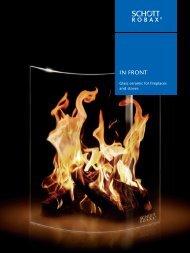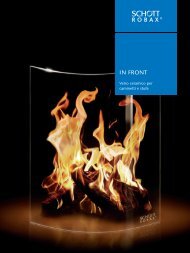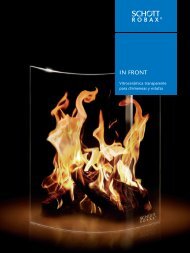SCHOTT Technical Glasses
Apart from its application in optics, glass as a technical material has exerted a formative influence on the development of important technological fields such as chemistry, pharmaceutics, automotive, optics, optoelectronics and information technology. SCHOTT Technical Glasses offers pertinent information in concise form. It contains general information for the determination and evaluation of important glass properties and also informs about specific chemical and physical characteristics and possible applications of the commercial technical glasses produced by SCHOTT. With this brochure, we hope to assist scientists, engineers, and designers in making the appropriate choice and make optimum use of SCHOTT products.
Apart from its application in optics, glass as a technical material has exerted a formative influence on the development of important technological fields such as chemistry, pharmaceutics, automotive, optics, optoelectronics and information technology. SCHOTT Technical Glasses offers pertinent information in concise form. It contains general information for the determination and evaluation of important glass properties and also informs about specific chemical and physical characteristics and possible applications of the commercial technical glasses produced by SCHOTT. With this brochure, we hope to assist scientists, engineers, and designers in making the appropriate choice and make optimum use of SCHOTT products.
Create successful ePaper yourself
Turn your PDF publications into a flip-book with our unique Google optimized e-Paper software.
14<br />
3. Mechanical and Thermal Properties<br />
3.1 Viscosity<br />
Between melting temperature and room temperature, the<br />
viscosity of glasses increases by 15 – 20 orders of magnitude.<br />
Within this viscosity range, glasses are subject to three different<br />
thermodynamic states:<br />
1. melting range – above liquidus temperature T s ;<br />
2. range of the supercooled melt – between liquidus temperature<br />
T s and transformation temperature T g ;<br />
3. frozen-in, quasi-solid melt (“glass range”), below transformation<br />
temperature T g .<br />
Volume ––><br />
3<br />
Glass formation<br />
curve<br />
4<br />
Crystallization<br />
curve<br />
Temperature ––><br />
Fig. 4. Schematic volume-temperature curves for crystallization and<br />
glass formation:<br />
1: liquid, 2: supercooled liquid, 3: glass, 4: crystal;<br />
T s : melting temperature, T g : transformation temperature<br />
The absence of any significant crystallization in the range of<br />
the supercooled melt (compare Figure 4 (2)) is of utmost<br />
importance for glass formation. Hence a basically steady and<br />
smooth change in the viscosity in all tem perature regions is<br />
a fundamental characteristic of glass (Figure 5).<br />
The temperature dependence of the viscosity (see Figure 6)<br />
is the crucial property for glass production.<br />
Melting and fining (homogenization) must generally take<br />
place at viscosities ≤ 200 dPa · s; for glasses with low melting<br />
temperature, 1 dPa · s can be achieved.<br />
T g<br />
2<br />
1<br />
T s<br />
Typical processing techniques for glasses, such as blowing,<br />
pressing, drawing and rolling, require viscosities in the<br />
range of 10 3 –10 7 dPa · s. As a characteristic temperature for<br />
this “working range,” generally the temperature for<br />
10 4 dPa · s, called the working point (ISO 7884-1), is measured<br />
and quoted (Table 20, p. 68ff). Depending on the<br />
magnitude of the temperature interval between 10 3 dPa · s<br />
and 10 7 dPa · s, one distinguishes between “long” (large<br />
temperature difference, shallow slope) and “short” glasses.<br />
At temperatures around the softening point, glass products<br />
deform rapidly under their own weight (forming by<br />
“sagging”), glass powders are sintered porously or densely,<br />
and glassblowing is carried out. The softening point is defined<br />
as the temperature at which the glass has a viscosity<br />
of 10 7.6 dPa · s (method of measurement: ISO 7884-3).<br />
Somewhat above 10 10 dPa · s, the viscosity becomes increasingly<br />
time-dependent. With increasing viscosity (i.e. decreasing<br />
temperature), the delay in establishing structural<br />
equilibria finally becomes so large that under normal cooling<br />
conditions the glass structure at 10 13 dPa · s can be described<br />
as solidified or “frozen-in.” The low flow capability at<br />
this viscosity only suffices to compensate for internal stresses<br />
lg η in dPa ·s ––><br />
15<br />
13<br />
11<br />
9<br />
7<br />
5<br />
3<br />
Transformation<br />
range<br />
Sintering,<br />
sagging<br />
Blowing<br />
Pressing,<br />
drawing<br />
10 14.5 dPa·s<br />
10 13 dPa·s<br />
10 7.6 dPa·s<br />
10 4 dPa·s<br />
Strain<br />
point<br />
Annealing<br />
point<br />
Softening<br />
point<br />
Working<br />
point<br />
Melting,<br />
casting<br />
1<br />
0 200 600 1000 1400 1800<br />
Temperature in °C ––><br />
Fig. 5. Typical viscosity-temperature curve; viscosity ranges for important<br />
processing techniques and positions of fixed viscosity points

















